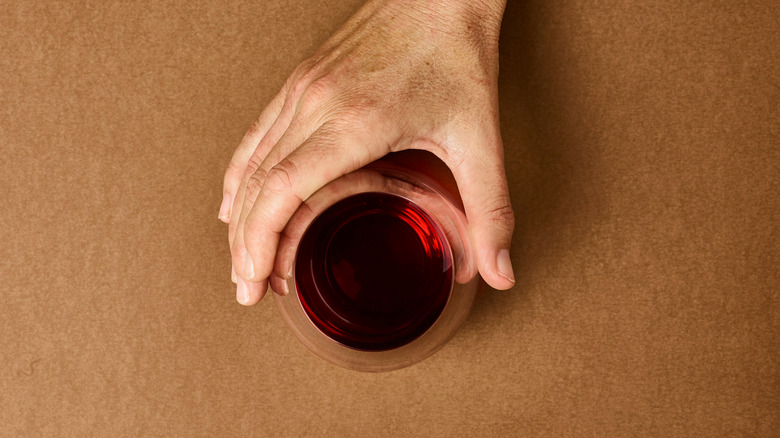The Right Way To Hold A Stemless Wine Glass
When you request a glass of wine at an open bar, a trendy new restaurant, or a friend's backyard gathering, there's a high chance someone will hand you a stemless glass full of your grape of choice. There's nothing wrong with that — the pared-down wine glasses are pleasantly casual, there are no stems to break, and they take up less storage space. However, for all their charms, the glassware's shape can instill panic among drinkers when they contemplate holding the chalices without warming up the drinks inside them.
Many of us — particularly white wine enthusiasts — have experienced this twinge of concern when wrapping our hot hands around a glass of chilled wine. To help you navigate this moment with confidence, we asked Maximilian Riedel, 11th-generation CEO and president of Riedel, for his opinion. As the leader of one of the most famous wine glass manufacturers in the world, Riedel knows a thing or two about cultivating the best possible drinking experience.
"For holding a stemless wine glass, you can hold onto the bottom part of the bowl and use your thumb, index finger, and middle finger to balance the glass," he shared. "Ultimately, a lower surface area of contact on your glass reduces the rate of heat transfer from your hand to the wine you're enjoying." Riedel made no mention of your palms, a clear hint that they should not rest against the glassware. If you need a little extra support, place your pinky across the bottom instead.
What's so bad about warm wine?
You may have wondered why it's frowned upon to serve a lukewarm white wine versus a chilled bottle, or to press your cool glass against your warm hands — wine is wine, after all. The answer comes down to temperature's effect on aroma. Colder temperatures can help draw out bright fruit and acid, while tamping down harsher notes of alcohol or bitter tannins.
When a sauvignon blanc or riesling is served at an appropriate 45 to 49 degrees Fahrenheit, this will pep up the vibrant flavors and crisp acidity, and send those fruity or citrusy aromas wafting into the air. The right amount of refrigeration will also dull or mute some of the more abrasive smells, particularly in a budget bottle. Some light red wines benefit from being chilled, too, as this can bring out their inherent fruitiness. That's why glassware experts like Maximilian Riedel advise minimal hand contact with your stemless glasses. You can also pour smaller servings and replenish more frequently from bottles you're keeping cold.
On the flip side, ice-cold vino can become downright tasteless with excess refrigeration, and you'll lose all the complexity hidden within your best bottles. Many heavy, dry reds, too, will become dull or bitter if they're allowed to become too cold. Here, warmth makes aromas more pronounced. As such, extra-chilled or tannin-rich wines, like the reds that pair well with burgers, are a better fit for those getting the hang of stemless sipping.


